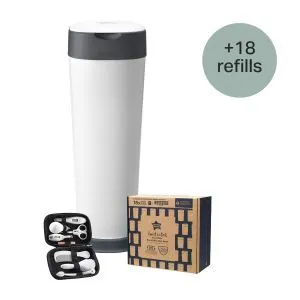
Ultimate XL Nappy Disposal Bundle with 18 Refills
Bundle & Save 40%
Subscription orders can be cancelled at anytime. Free delivery on all subsequent subscription orders. Find out more about subscriptions.
They’re easy and fuss free
Your products are automatically sent to you
You save up to 10% when you sign up for a subscription
You can cancel at any time

If your baby uses a dummy, you’ll soon become aware of how often it ends up being dropped on the floor and may be wondering "How do I keep my baby's dummy clean?”.
Keeping a baby’s dummy clean is essential to protect them from illness. Young babies are very susceptible to germs and bacteria which can accumulate on dummies. So, it’s important to clean and sterilise their dummies regularly (even if the dummy looks clean to the naked eye).
By following these simple guidelines, you can help make sure your child's dummy stays clean, safe and ready to soothe.
Dirty dummies can make babies unwell, so it’s important to keep your baby’s soothers clean. Poor dummy hygiene could increase the risk of illnesses like:
You should clean and sterilise any new soothers you buy your baby before you use them for the first time, and again before every use.
Explore the Range
You can buy small sterilisers that are specially designed for baby soothers, but if you have other items (like baby bottles, breast pumps, and teething rings) to clean, a larger steriliser will come in handy!
Tommee Tippee sterilisers use UV light or 100% natural steam to kill viruses* and 99.9% of bacteria.
*Tested against Coronavirus (tested to EN 16777) and Influenza H1N1.
All two-pack Tommee Tippee soothers come packaged in a reusable case for simple microwave sterilising, at home or on the go.
Here’s how it works:
You can also buy specially designed microwave sterilising bags for baby soothers which can be helpful when out and about.
When your baby isn't using their soother, it’s best to sterilise it, then keep it stored in a clean, dry, covered container.
Explore the Range
Some baby dummies can be cleaned in the dishwasher, but it's important to note that this method doesn't sterilise them.
You should replace your baby’s dummy every month or right away at the first signs of any damage or weakness. It’s best to check their dummy before every use, just to be safe.
No, it is not okay to suck a baby's dummy to clean it. Sucking on the dummy is not a hygienic way to clean it because your saliva contains bacteria that can be harmful to the baby's developing immune system. By sucking on the dummy, you can transfer germs from your mouth to the baby, which can lead to the spread of infections and illnesses.
Generally, you can stop sterilising your baby's dummies around 12 months of age. By this time, their immune system will have developed enough to handle most germs. Here's a quick breakdown:
Always check the specific recommendations and the instructions for the dummies you use. Some brands might have slightly different guidelines.